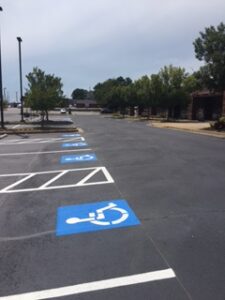
What Weather Factors Influence an Asphalt Company When Deciding on the Advisability of Sealcoating?
There are three factors that are critical to the success of an asphalt sealcoating job. These are rain, humidity, and temperature. Two other factors, sunlight and wind speed, are important, but they are not as significant unless the humidity, temperature, or both are barely within acceptable tolerances. However, when it comes to rain, there is no acceptable range; if it rains less than 24 hours after the completion of a sealcoating application, the performance, appearance, and longevity of the job can be compromised.
Why Are Humidity Levels and Temperatures Critical for Successful Paving Projects?
At this point, it might be helpful to discuss the process of evaporation as it relates to sealcoating, which contains a high percentage of water in its liquid state. If you place a bowl of water on a counter at room temperature, it will take much longer to evaporate than a pan containing the same amount of water that you heat on your stove. Water molecules escape by bouncing around until they get bounced out of the liquid. The cooler it is, the more sluggish the molecules are, so they do not escape as quickly. Heat excites the molecules, making them collide more often and at greater speeds, so more molecules are able to escape into the air. However, if the humidity levels above the liquid are elevated, the air will have less room to accept the molecules, leaving them trapped in the liquid until the air can accommodate them.
How Might Wind and Sunlight Affect a Sealcoating Project?
Ironically, the UV rays that can damage asphalt pavement can also help sealcoating cure. Furthermore, sunlight makes the liquid sealant warmer, and it also helps the sealant retain heat for a longer period. Wind is important because it moves the water-saturated air away from the surface of the pavement, replacing it with drier air that has more room for escaping water molecules. Therefore, when temperatures and relative humidity levels are borderline, the amount of sunshine and the wind speed can be the deciding factors on whether to sealcoat a pavement in the spring. It should also be noted that the same factors can impact your plans to have your asphalt paving or maintenance contractor apply your parking lot striping immediately after sealcoating.
Trust the Asphalt Sealcoating and Lot Striping Experts at MH Greeson
At MH Greeson, we understand the factors that impact sealcoating projects in the spring. We are sealcoating experts, and our paving services also include pavement marking and lot striping, professional asphalt maintenance plans, bollard and traffic sign installations, asphalt repairs, car stops, and asphalt crack repairs. We have an impeccable reputation for integrity, professionalism, exemplary craftsmanship, and unparalleled customer service. You can get a free job quote by submitting our online request form or calling 770-335-2983.




